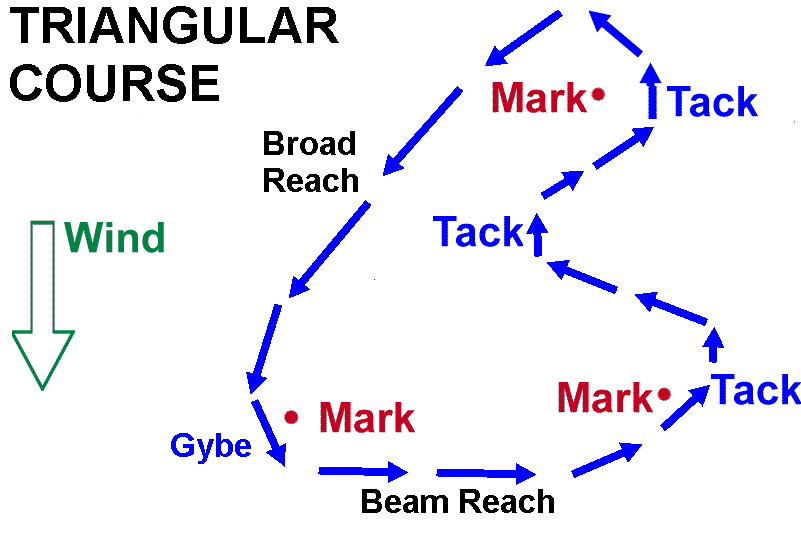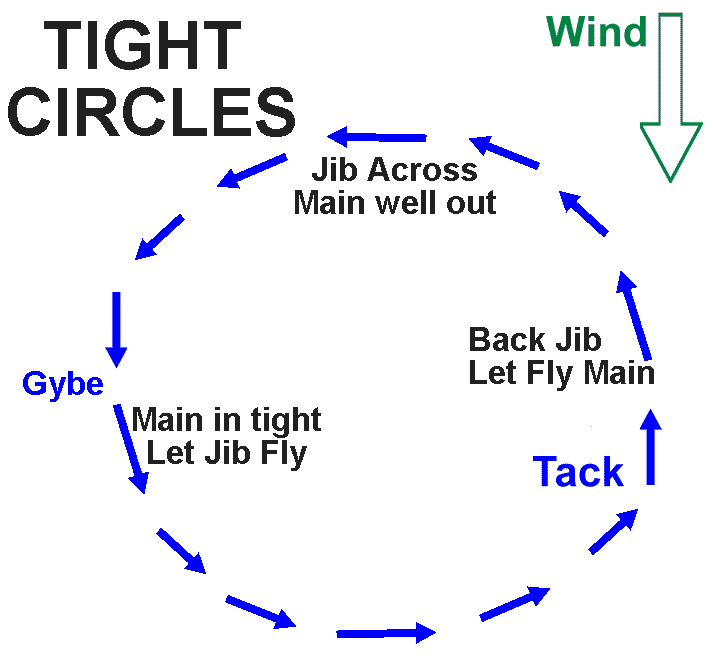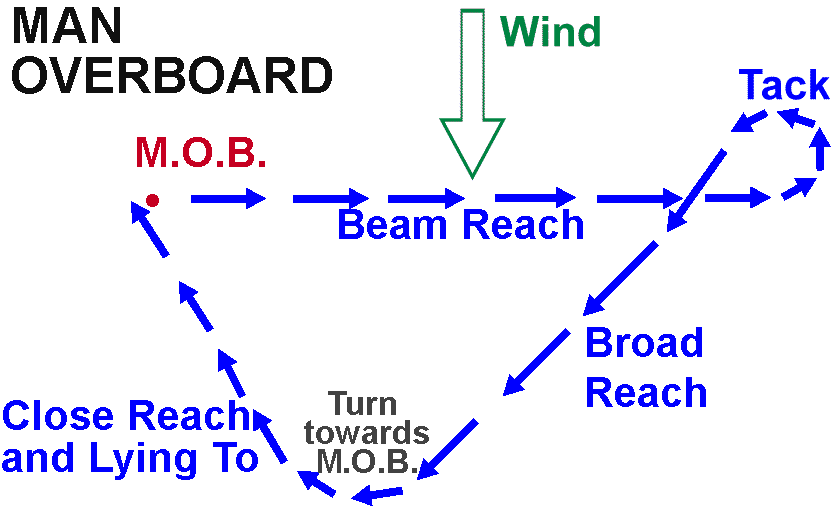Sailing Techniques and Exercises
These are intended as FUN exercises to do, to progress sailing ability and practise skills. Find the level and type of exercise suitable for the trainees. Don't pursue any of them beyond the point where they are still interesting and useful.
Some of them can be done best using marks to sail round or up to. On some broads there are posts you can use for one or more of the marks, but you may need to put your own in, possibly for each squadron. You can make a buoy out of a fender and at least 2m of sail tie or thin rope (but not more than 4m) very, very firmly attached to one or two rond anchors; and/or use a quant pole as a marker.
Figure of Eight Course
For practising Tacking and Reaching (a great introduction).
Lay or choose a suitable Figure of Eight course, using two marks set roughly perpendicular to the wind direction (see diagram). They could be between 5 and 10 boat lengths apart. Choose an area to sail that is not too crowded(!). This exercise is possible without marks, but is much better if you've actually got something to sail around.

Sail around the marks in a Figure of Eight shape, pointing upwind as you round each mark (i.e. tacking), and on a beam/broad reach between them. Encourage good boat control, demonstrated by being fairly close to the marks.
Take turns getting each member of the crew to sail round two or three times. If they get really confident and winds are light, change to a Gybing Figure of Eight to show the difference.
Triangular Course
This is excellent for practising all points of sailing, including quick tacking and a gybe turn.
Lay or choose a suitable Triangular course (possibly for your squadron), using any available posts, buoys or moored (Pathfinder) boats, plus marks that you place. Make your marks as described above. Have one leg of the course roughly upwind, and it should form a vaguely equilateral triangle. For a start, make each side of the triangle slightly over five boat lengths. As the crew gets better, make the course smaller, to give more challenge to their boat control.

Sail fairly close to the marks, putting in at least three tacks on the upwind leg (i.e. as soon as you're sailing, tack again).
With improvement, and as a further challenge, ask for 5 or 7 tacks.
Take turns getting each member of the crew to sail round two or three times.
Watch for closeness to the marks as well as appropriate and prompt sail setting.
Slowing Down ('Lying To')
For coming up to a mark, a mooring or anchoring.
Bring the boat onto a close reach (but not head to wind), then let both sails out completely to slow down. You can pull in the mainsheet to speed up, or let go to slow down again, but aim to hold your course steady. This is useful for all sorts of purposes, including safe helmsman swap-over, etc.
Try it coming up to a mark or windward shore, aim to arrive under control and just stopped. Approach close-hauled, let both sails free to slow down, pull in the main to speed up, hold your course steady.

Tight Circles
For demonstrating sail handling and tight manoeuvres, plus how each of the sails affects the boat's direction.
Back the jib as soon as you've tacked, leaving the mainsheet completely free; keep the mainsheet tight as soon as you've gybed and hold it in (leaving the jib free) until you tack.
Feel the two sails drive the boat round as you work them in turn. You should find that you hardly need to touch the tiller at all while doing this, especially on smaller yachts or with the mainsail reefed.
This can be done around a freely-drifting dinghy, possibly with someone in it offering (helpful) advice. Try to be less than one boat length from the dinghy. Don't forget to pick up the dinghy (approach 'lying to'); you may need to plan how to retrieve it from a lee shore.
Follow My Leader
(by squadron or a group of boats)More practice of boat control and quick reactions on different points of sailing.
Can be combined with Triangular course (see above). The 'leader' boat should change course frequently, possibly slowing down to really test the 'followers'. Aim to be less than one boat length apart. Swap over helmsman during the exercise to give everyone a chance.
Man Overboard
Show boat handling on nearly all points of sailing and stopping under control at a specific point.

Remember - Sail off on a Beam Reach, then Tack quickly, Broad Reach until you turn up towards the M.O.B. on a Close Reach/Lying To; let fly sheets to slow down, pull in the main to speed up, keep watching the M.O.B., aim be stationary with it beside the Windward shrouds.
Aim to get it reasonably right, say three times out of five; try to realise why it went wrong when you didn't!
Don't use a life-ring, as it drifts downwind too quickly. You could use a fender with a rond anchor and/or a bucket tied closely to it.
ADVANCED TECHNIQUES
Rudderless Sailing
To show how the set of the sails controls the direction of the boat.
Let go of the tiller and steer with the sheets: pull in the Jib to turn away from the wind or pull in the Main to turn towards the wind (not all the boats will do this terribly well, but have a go). See if you can tack and gybe without touching the helm, and also keep a straight course!
Sailing Backwards
For making you really think about the action of the rudder, and to get away from a crowded windward shore or flotilla mooring (and even to show off a bit!).
Start with the boat head to wind and absolutely stationary. Get one or more crew on the cabin roof to hold out the boom, without risking falling in. Stand ahead of the tiller and look aft along it, moving it so the pivot end points to where you want to go (a place downwind). Break out of it carefully, ideally turning so that the side the boom is on ends up as the lee side (without swinging across and swiping everybody into the drink).